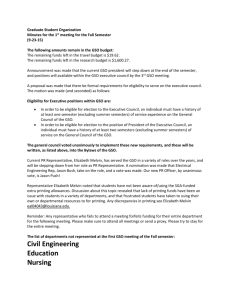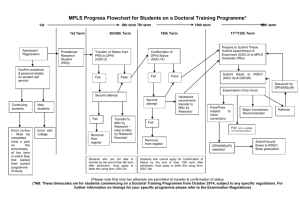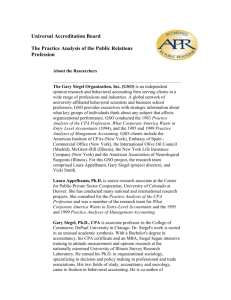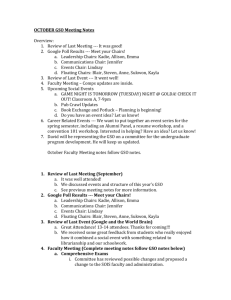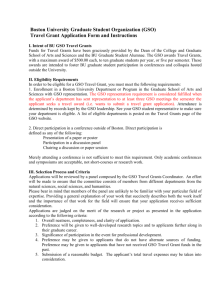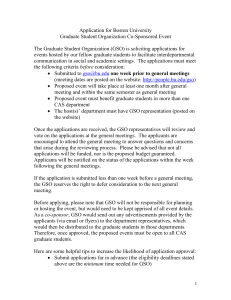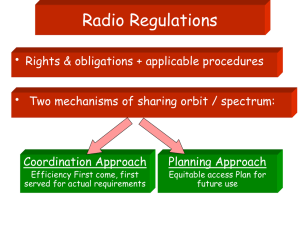RECOMMENDATION ITU-R S.1591 - Sharing of inter
advertisement
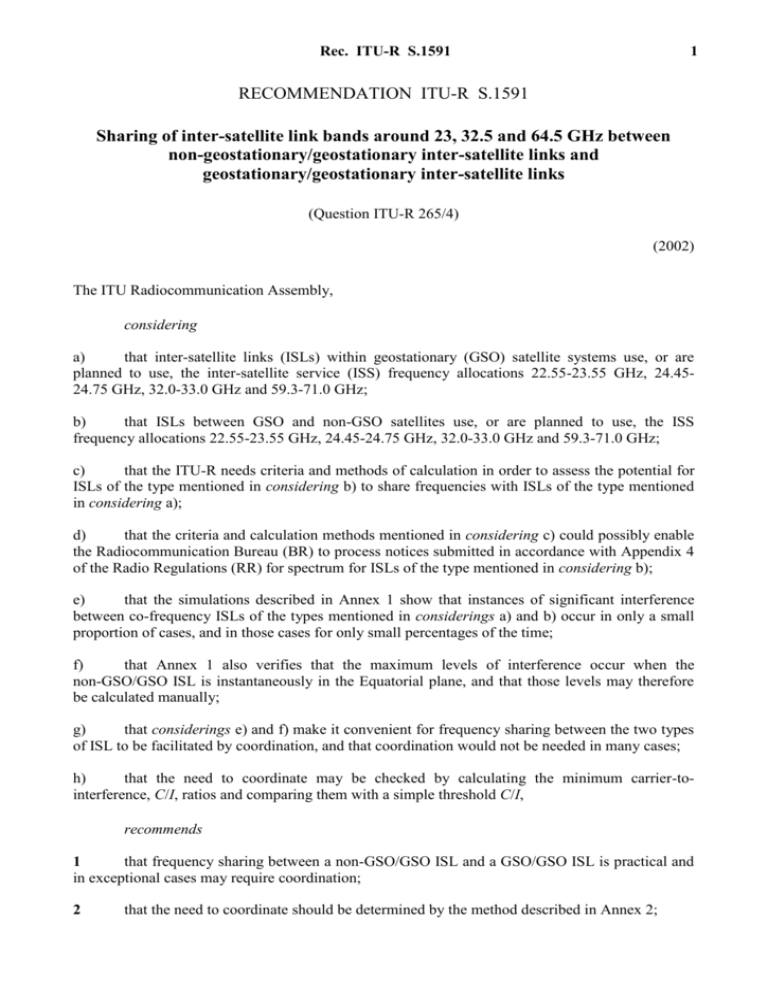
Rec. ITU-R S.1591
1
RECOMMENDATION ITU-R S.1591
Sharing of inter-satellite link bands around 23, 32.5 and 64.5 GHz between
non-geostationary/geostationary inter-satellite links and
geostationary/geostationary inter-satellite links
(Question ITU-R 265/4)
(2002)
The ITU Radiocommunication Assembly,
considering
a)
that inter-satellite links (ISLs) within geostationary (GSO) satellite systems use, or are
planned to use, the inter-satellite service (ISS) frequency allocations 22.55-23.55 GHz, 24.4524.75 GHz, 32.0-33.0 GHz and 59.3-71.0 GHz;
b)
that ISLs between GSO and non-GSO satellites use, or are planned to use, the ISS
frequency allocations 22.55-23.55 GHz, 24.45-24.75 GHz, 32.0-33.0 GHz and 59.3-71.0 GHz;
c)
that the ITU-R needs criteria and methods of calculation in order to assess the potential for
ISLs of the type mentioned in considering b) to share frequencies with ISLs of the type mentioned
in considering a);
d)
that the criteria and calculation methods mentioned in considering c) could possibly enable
the Radiocommunication Bureau (BR) to process notices submitted in accordance with Appendix 4
of the Radio Regulations (RR) for spectrum for ISLs of the type mentioned in considering b);
e)
that the simulations described in Annex 1 show that instances of significant interference
between co-frequency ISLs of the types mentioned in considerings a) and b) occur in only a small
proportion of cases, and in those cases for only small percentages of the time;
f)
that Annex 1 also verifies that the maximum levels of interference occur when the
non-GSO/GSO ISL is instantaneously in the Equatorial plane, and that those levels may therefore
be calculated manually;
g)
that considerings e) and f) make it convenient for frequency sharing between the two types
of ISL to be facilitated by coordination, and that coordination would not be needed in many cases;
h)
that the need to coordinate may be checked by calculating the minimum carrier-tointerference, C/I, ratios and comparing them with a simple threshold C/I,
recommends
1
that frequency sharing between a non-GSO/GSO ISL and a GSO/GSO ISL is practical and
in exceptional cases may require coordination;
2
that the need to coordinate should be determined by the method described in Annex 2;
2
Rec. ITU-R S.1591
3
that coordination should take place if the minimum C/I ratio in a bandwidth of 1 MHz at
any of the four ISL receivers, calculated by the method in Annex 2, is less than either the C/N
identified for that receiver in item C.8 e) of RR Appendix 4 3 dB or, in the absence of a C/N,
30 dB;
4
that, in cases where coordination is found to be necessary from recommends 2 and 3,
Annex 1 may be used by the coordinating parties for guidance.
ANNEX 1
Investigation of interference between a non-GSO/GSO
ISL and a GSO/GSO ISL
1
The feasibility of frequency sharing by ISLs
In general, systems with ISLs in microwave bands have or are expected to have antenna diameters
between 0.5 and 2 m. The lowest frequency ISS allocation is 22.55 to 23.55 GHz, and in this
frequency range a 0.5 m antenna has a gain of about 39 dBi and a half-power beamwidth of about
2°. For larger diameters and higher frequencies, the beamwidths can be a fraction of a degree.
The angular range over which an ISL antenna may be pointed is large, thus reducing the probability
of conjunctions or near conjunctions with interfering ISLs. The number of systems using the ISS
allocations in the year 2001 was small. It is anticipated that this number will grow, but will
probably be limited by the introduction of optical communications in space, and in any case it could
not be expected to be as many as the number of systems with fixed-satellite service (FSS) links,
which successfully share frequencies by means of coordination.
Interference, to or from any ISL that has a non-GSO satellite, is dependent on time-varying
geometry. Hence, instances of significant interference will occur for only short durations in
situations at or very close to the worst-case geometry. At all other times the antenna discrimination
at one or both ends of the interference path will be substantial and this will reduce the interference
power.
2
Selection of ISL parameters for computation of interference statistics
From a BR database compiled from filings for spectrum assignments, the transmission parameters
of ISLs of both types in all three frequency bands associated with a number of MEASAT GSO and
MEASAT low Earth orbit (LEO) satellites (Malaysia) were obtained. Also obtained from this
source were parameters of 32 GHz ISLs associated with satellites in the LUXSAT series
(Luxembourg), and of 67 GHz ISLs associated with satellites in the SMO-GEO series (France).
Additionally, relevant information on GSO/GSO ISLs was extracted from Recommendations
ITU-R S.1151 (32.5 GHz), ITU-R S.1326 (51 GHz FSS band) and ITU-R S.1327 (62.2 GHz).
Rec. ITU-R S.1591
3
At the time of writing the United States of America has several space systems with ISLs in the ISS
allocations between 56 GHz and 65 GHz; they are USBL, USFD, USGAE, USGX, USLL, and
MILSTAR. Some of these systems are in the planning or design phase, others are under
development, and others in operation. The orbits used by these systems include LEOs, high Earth
orbits (HEOs) and the GSO. The orbit combinations for their ISLs include, inter alia, GSO to GSO,
LEO to and from GSO, and HEO to and from GSO.
Finally, reference was made to Recommendation ITU-R S.1328 for orbital and other pertinent data
on non-GSO FSS systems employing on-board processing, which might include ISLs in the bands
of interest.
To keep the study within practicable bounds it was decided to review all of the available data and
then compile sets of parameters for a LEO/GSO ISL, a medium Earth orbit (MEO)/GSO ISL and a
GSO/GSO ISL, each of which is hypothetical but has characteristics which are typical of those in
the filed systems. Four examples of the GSO/GSO ISL were included, and the parameters produced
in this way are shown in Table 1.
For the non-GSO end of the non-GSO/GSO link the nearest satellite handover strategy was
modelled. The antenna pattern modelled in each case was as defined by Recommendation
ITU-R S.672 (single feed, –25 dB first sidelobe). Each ISL was treated as an individual link (i.e. no
use was made of transmission gains coupling an ISL with a preceding or following link). The case
of multiple satellites in an interfering system transmitting simultaneously toward the same satellite
was not modelled; it is expected that this would lead to only slightly smaller minimum values of C/I
than those in the present exercise; the minimum C/I instances would occur more often, but in
practical cases would still aggregate to small percentages of time.
Since the e.i.r.p. required for a given ISL depends inter alia on its length, it was necessary to
calculate the e.i.r.p. separately for each link, and this was done assuming an operating C/N of 15 dB
at the input to each receiver, as follows:
e.i.r.p. – 20 log (4 d/) G – 10 log (k T B) 15 dB
where:
d : path length (m) (maximum in the non-GSO/GSO case)
: wavelength (m)
G : on-axis gain of the receiving antenna (dBi)
k : Boltzmann’s constant (–228.6 dB(W/(Hz K)))
T : link noise temperature referred to receiver input (K)
B : reference bandwidth (1 MHz).
4
Rec. ITU-R S.1591
TABLE 1
Parameters of typical inter-satellite links in ISS bands below 71 GHz
ISL type
LEO/GSO
MEO/GSO
GSO/GSO
(A)
Shape of orbits
Height of orbits (km)
Number of orbit
planes
Number of satellites
per plane
Non-GSO inclination
(degrees)
Ascending node
displacement
(degrees)
1 400
7 (GSO)
10 360
4 (GSO)
1
2
48
82.5
0
25.714
45
0
Longitude(s) of GSO
satellite(s) (°E)
–3
Not available
0 and 159.3
Not available
Nearest LEO
satellite
Nearest MEO
satellite
Not available
Tracking
0 and 9.99
Fixed
1
ISL antenna peak
gain (dBi)
23 GHz
32.5 GHz
62.2 GHz
45.4
48.4
54.0
ISL antenna pattern
Recommendation ITU-R S.672
LN –25 dB
ISL beamwidth
(degrees)
23 GHz
32.5 GHz
62.2 GHz
0.91
0.65
0.34
Variable,
maximum 43
Variable,
maximum 45
83 128
C/N at receiver input
(dB)
ISL system noise
temperature (K)
0 and 133.23
45
ISL antenna
diameter (m)
e.i.r.p./MHz (dBW)
0 and 158.74
28.57
Satellite beam
pointing method
ISL length (km)
GSO/GSO
(D)
35 786
9 (1 in GSO) 6 (1 in GSO)
0
Hand-over strategy
GSO/GSO
(C)
Circular
True anomaly
displacement
(degrees)
Adjacent plane
phasing (degrees)
GSO/GSO
(B)
82 877
77 396
7 339
47.5
46.9
26.5
15
41.8
42.4
47.6
700
Rec. ITU-R S.1591
3
5
Simulation model
The geometrical details of the four GSO/GSO ISLs are given in Fig. 1. Although manual
calculations of the maximum interference levels in both forward and return directions of
transmission were made, in order to check the results of those calculations by simulation it was only
necessary to model one direction in the present case. The model was set up to simulate
transmissions from satellite SG1 to SG2 and from SN1 to SN2, and hence interference from SN1 to
SG2 and from SG1 to SN2. Satellite SN1, not shown explicitly in Fig. 1, is in the non-GSO
constellation and changes from time to time as determined by the tracking strategy.
FIGURE 1
Example GSO/GSO ISL
GSO
radius
42 162 km
SG1C
SG1A
SG1B
OA = 7 576 km
OB = 7 776 km
OC = 16 736 km
OD = 42 002 km
MEO shell
radius
16 736 km
GSO/GSO
ISL(A)
GSO/GSO
ISL(B)
SG2OSG1A = 159.3°
SG2OSG1B = 158.7°
GSO/GSO
ISL(C)
SG2OSG1C = 133.2°
SG2OSG1D = 10°
SN2OSG2 = 3°
C
A
B
O
GSO/GSO
ISL(D)
D SG1D
LEO shell
radius
7 776 km
SG2
SN2
i.e. GSO end of
non-GSO/GSO
1591-01
6
Rec. ITU-R S.1591
For the main runs the geocentric separation between one end of each GSO/GSO link and the GSO
end of each non-GSO/GSO link was 3°, since this is the minimum spacing for most co-frequency,
co-coverage GSO/FSS systems. Thus SG2 was located at 0° and SN2 at 3° W. For GSO/GSO
ISL(A) the longitude of the satellite at the other end (SG1(A)) was set at 159.3° E, which makes it
the longest ISL which could possibly create interference from SG1(A) to SN2; for a longer ISL the
interference path would be blocked by the Earth. GSO/GSO ISL(B) was set up to be tangential to
the orbit “shell” of the LEO constellation, and GSO/GSO ISL(C) to be tangential to the orbit shell
of the MEO constellation. GSO/GSO ISL(D), a short ISL spanning a longitude range of only 10°
was included for the sake of completeness.
This model enabled 48 sets of C/I statistics to be obtained in a single run, i.e.:
a)
LEO/GSO ISL interference to GSO/GSO ISL(A) in each of the three ISS bands,
b)
LEO/GSO ISL interference to GSO/GSO ISL(B) in each of the three ISS bands,
c)
LEO/GSO ISL interference to GSO/GSO ISL(C) in each of the three ISS bands,
d)
LEO/GSO ISL interference to GSO/GSO ISL(D) in each of the three ISS bands,
e)
MEO/GSO ISL interference to GSO/GSO ISL(A) in each of the three ISS bands,
f)
MEO/GSO ISL interference to GSO/GSO ISL(B) in each of the three ISS bands,
g)
MEO/GSO ISL interference to GSO/GSO ISL(C) in each of the three ISS bands,
h)
MEO/GSO ISL interference to GSO/GSO ISL(D) in each of the three ISS bands,
i)
GSO/GSO ISL(A) interference to LEO/GSO ISL in each of the three ISS bands,
j)
GSO/GSO ISL(B) interference to LEO/GSO ISL in each of the three ISS bands,
k)
GSO/GSO ISL(C) interference to LEO/GSO ISL in each of the three ISS bands,
l)
GSO/GSO ISL(D) interference to LEO/GSO ISL in each of the three ISS bands,
m)
GSO/GSO ISL(A) interference to MEO/GSO ISL in each of the three ISS bands,
n)
GSO/GSO ISL(B) interference to MEO/GSO ISL in each of the three ISS bands,
Rec. ITU-R S.1591
7
o)
GSO/GSO ISL(C) interference to MEO/GSO ISL in each of the three ISS bands, and
p)
GSO/GSO ISL(D) interference to MEO/GSO ISL in each of the three ISS bands.
Each run was continued until about six days of orbit time had been simulated, using time steps of
1 s, thus computing about 6 24 60 60 518 400 samples of C/I for each of the 48 scenarios.
This was sufficient to obtain a smooth cumulative distribution function (CDF) in each case.
4
Results
The model was first run for the reference scenario, in which satellite S N2 was located at
3° W i.e. 3° from satellite SG2, and the results were plotted as cumulative time distributions of
C/I. As expected, the interference varied with time in every case which confirms the wisdom of
basing frequency sharing on a short-term criterion. For most of the links even the short-term
interference was negligible, and in no case did the C/I fall to a value anywhere near a likely
interference threshold. The minimum C/I occurred for interference from the 23 GHz MEO/GSO
ISL to GSO/GSO ISL(B) and was about 31.5 dB. As examples the results for this case and for the
“best” case – GSO/GSO ISL(D) – are shown in Figs. 2 and 3; the other plots (14 Figures each with
three graphs) were prepared.
FIGURE 2
MEO/GSO ISL interference to GSO/GSO ISL(B)
Percentage of time C/I < abscissa value
102
32.5 GHz
10
62.2 GHz
23 GHz
1
10–1
10–2
10–3
10–4
20
28
36
44
52
60
C/I (dB)
68
76
84
92
100
1591-02
8
Rec. ITU-R S.1591
FIGURE 3
GSO/GSO ISL(D) interference to LEO/GSO ISL
2
Percentage of time C/I < abscissa value
10
62.2 GHz
32.5 GHz
23 GHz
10
1
10–1
10–2
92
90
94
96
98
100
102
104
106
C/I (dB)
108
110
1591-03
NOTE 1 – Figure 2 shows the lowest of the 48 sets of C/I statistics and Fig. 3 shows the highest.
By carrying out further runs with satellite SN2 in various longitudes relative to SG2 it was confirmed
that, as anticipated, the lowest C/I ratios occur when SN2 is close to SG2. It was therefore decided to
run the simulation for successively smaller SN2-SG2 separations, in order to determine the
circumstances under which frequency sharing might be difficult. The lowest C/I ratios thus obtained
are listed in Table 2. These are all for 23 GHz; the ratios increase with increasing frequency in
every case because of increasing antenna gain.
TABLE 2
Lowest C/I ratios from simulations with SN2 close to SG2
Angle between
SN2 and SG2
(degrees)
Interfering ISL
Victim ISL
Lowest C/I
(dB)
3
MEO/GSO
GSO/GSO(B)
31.3
2
GSO/GSO(A)
MEO/GSO
19.3
1.5
GSO/GSO(A)
MEO/GSO
13.0
1.0
GSO/GSO(A)
MEO/GSO
14.4
0.5
MEO/GSO
GSO/GSO(A)
4.6
From Table 2 it is evident that, for co-frequency operation of typical ISLs, satellite SN2 could be
safely located at longitudes with respect to SG2 down to 3° without creating unacceptable
interference peaks, and hence coordination would not be necessary if the geocentric angle between
SN2 and SG2 was greater than 3°.
Rec. ITU-R S.1591
9
Finally, checks were made to ensure that the minimum values of C/I occur at some of the instants
when the non-GSO satellite in a non GSO/GSO ISL is passing through the Equatorial plane. This
was done by carrying out a run to identify when the minimum C/I on a given link occurred, and
then repeating that part of the run whilst plotting C/I against time. An example of this process is
illustrated in Fig. 4, where both the upper and lower diagrams were printed from the simulation for
the 23 GHz non-GSO/GSO ISLs interfering with GSO/GSO ISL(A) when SN2 was separated from
SG2 by only 0.5°. The lower diagram is a view from a point in space in the Equatorial plane at
90° E longitude, looking down at the Earth, at the time-step corresponding to T in the upper
diagram. Satellite SN1 in the MEO/GSO ISL can be seen to be passing through the Equatorial plane
at this instant. Satellite SN1 in the LEO/GSO ISL is south of the Equatorial plane at this instant, but
by a similar exercise it was confirmed that the minimum C/I occurs during certain crossings of the
Equatorial plane in that case also.
5
Conclusions
The foregoing results suggest that in the great majority of cases non GSO/GSO ISLs will be able to
operate co-frequency with GSO/GSO ISLs without the need for coordination, provided that the
geostationary satellite in the non-GSO/GSO ISL is not located within 3° of either satellite in the
GSO/GSO ISL. It has also been shown that the minimum C/I ratios occur at some instants when the
non-GSO satellite in the non-GSO/GSO ISL is passing through the Equatorial plane. Given a
decision that frequency sharing should be facilitated by a coordination procedure, these two factors
lead to a simple method which may be used for determining whether or not coordination is
necessary, and which is described in Annex 2. The method requires a short-term C/I threshold as a
basis for the coordination trigger.
In the light of this study the following answers to the decides in Question ITU-R 265/4 seem
appropriate, insofar as the sharing of non-GSO/GSO ISLs with GSO/GSO ISLs in the ISS bands
near 23 GHz, 32.5 GHz and 62.2 GHz is concerned.
Since the method for determining the need to coordinate described in Annex 2 is based on
calculating the minimum C/I ratio, and this occurs for only a small proportion of the time
(e.g. < 0.1% as illustrated in Fig. 2), a threshold 3 dB above the C/N ratio corresponding to the
performance objective would be a sufficiently conservative trigger level. Therefore, for use in the
method of Annex 2: coordination should take place if the minimum C/I ratio in a bandwidth of
1 MHz at any of the four ISL receivers, is less than either the C/N identified for that receiver in item
C.8 e) of RR Appendix 4 3 dB or, in the absence of a C/N, 30 dB.
It is to be noted that the first part of this threshold adapts to the need of each ISL receiver, while the
second part, applied only when RR Appendix 4 item C.8 e) is not available for a particular receiver,
gives a threshold that satisfies the requirements that have been stated by administrations.
10
Rec. ITU-R S.1591
FIGURE 4
Example of passage through Equatorial plane corresponding to minimum C/I
MEO/GSO ISL interference to GSO/GSO ISL(A) at 23 GHz
satellite SN2 0.5° from satellite SG2 in the GSO
7.0
6.5
C/I (dB)
6.0
5.5
5.0
4.5
4.0
–50
–40
–30
–20
Relative simulation time (s)
–10
0
T
Direction of interfering ISL at time T
Satellite
SN2
MEO/GSO ISL
SN1
Equatorial plane
LEO/GSO ISL
Note – GSO/GSO ISLs not shown.
1591-04
Rec. ITU-R S.1591
11
ANNEX 2
Method for determining whether coordination is necessary for a
non-GSO/GSO ISL sharing frequency with a GSO/GSO ISL
The method applies to the ISS bands between 22 GHz and 71 GHz, if there is frequency overlap
between a carrier in a non-GSO/GSO ISL and a carrier in a GSO/GSO ISL. If there is no frequency
overlap coordination is of course unnecessary.
A diagram similar to Fig. 5 should be drawn, but using the actual longitudes proposed for the
geostationary satellites at each end of the GSO/GSO ISL and at the GSO end of the non-GSO/GSO
ISL. Note that Fig. 5 illustrates an instant when SN1 is in line with SG1 and SN2.
If angle 3° and the line SG1SN2 does not intersect the orbit shell of the non-GSO system
concerned, then it should be concluded that coordination is not necessary.
Regardless of the value of angle , if the line SG1SN2 intersects the orbit shell of the non-GSO
system concerned or if angle < 3° and the line SG1SN2 does not intersect the orbit shell of the
non-GSO system concerned, then path lengths SG1SG2, SN1SN2, SG1SN2 and SN1SG2 should be
calculated (km), and off-axis angles G1, G2 and N1 should also be calculated (degrees), in the
manner explained in Fig. 5 and the subsequent equations. Note that, if the line SG1SN2 intersects the
orbit shell of the non-GSO system, then angle N2 0° at each in-line instant. The e.i.r.p. per MHz
(E) of each ISL, in each direction of transmission should then be calculated by subtracting 10 log
(carrier bandwidth (MHz)) from the operational carrier e.i.r.p.. Finally, the C/I should be calculated
as follows:
(C/I )G1 EG2 – EN2 DT(N2) DR(G1) 20 log[(SN2SG1)/(SG2SG1)]
dB
(C/I )G2 EG1 – EN1 DT(N1) DR(G2) 20 log[(SN1SG2)/(SG1SG2)]
dB
(C/I )N1 EN2 – EG2 DT(G2) DR(N1) 20 log[(SG2SN1)/(SN2SN1)]
dB
(C/I )N2 EN1 – EG1 DT(G1) DR(N2) 20 log[(SG1SN2)/(SN1SN2)]
dB
where DT is the discrimination (dB) given by the on-axis gain minus the gain at the off-axis angle
concerned of the antenna transmitting the interference, and similarly DR (dB) is the discrimination
of the antenna receiving the interference. Note that, if the line SG1SN2 intersects the orbit shell of
the non-GSO system, then DT(N2) DR(N2) 0 dB at each in-line instant. (It is assumed that the
ISL antenna patterns would be included in the information supplied in RR Appendix 4. Otherwise
the single-feed pattern in Recommendation ITU-R S.672 could be used.)
If these four C/I ratios are all greater than or equal to the threshold, it should be concluded that
coordination is not necessary; if one or more is less than the threshold it should be concluded that
coordination is required. The threshold for each of the four ISL receivers is the C/N identified for
that receiver in item C.8 e) of RR Appendix 4 3 dB or, in the absence of a C/N, 30 dB.
12
Rec. ITU-R S.1591
FIGURE 5
Geometry for coordination trigger
SG1
GSO
G1
Non-GSO
shell
O
SN1
G2
SN2
SG2
1591-05
The bold variables below are those needed for the C/I equations in the text above Fig. 5.
OSG1 OSG2 OSN2 42 162 km. OSN1 (6 376 h) km, where h is height of non-GSO (km).
SG1SG2 [2 (42 162)2 {1 – cos()}]0.5 and OSG1SG2 sin–1[(42 162) sin()/(SG1SG2)].
In the equations below, except of the last one the plus () sign is to be used if SN2 is outside the arc
between SG1 and SG2 (i.e. the arc associated with angle ) and the minus (–) sign is to be used if
SN2 is inside that arc.
SG1SN2 [2 (42 162)2 {1 – cos( )}]0.5 and OSG1SN2 sin–1[(42 162) sin( )/(SG1SN2)].
Then G1 (OSG1SG2 – OSG1SN2) /2
Rec. ITU-R S.1591
13
If the line SG1SN2 intersects the orbit shell of the non-GSO system concerned, then continue with
the equations labelled “equations for intersection”. If angle < 3° and the line SG1SN2 does not
intersect the orbit shell of the non-GSO system concerned, then continue with the equations labelled
“equations for no intersection”.
Equations for intersection
OSN1SG1 sin–1[(42 162) sin(OSG1SN2)/(6 376 h)], and
SG1OSN1 180° – OSG1SN2 – OSN1SG1
SG1SN1 [(42 162)2 (6 376 h)2 – 2 (42 162) (6 376 h) cos(SG1OSN1))]0.5,
and SN1SN2 SG1SN2 – SG1SN1
Also SN1SG2 [(SG1SN1)2 (SG1SG2)2 – 2 (SG1SN1) (SG1SG2) cos(G1)]0.5
G2 sin–1 [(SG1SN1) sin(G1)/(SN1SG2)], and N1 G1 G2
N2 SG1SN2SN1 = 0°
Equations for no intersection
For this case the position of SN1 is indeterminate since it is not on the line between SG1 and SN2. To
fix a location for SN1, place it as close as possible to the line SG1SG2, so that OSN1 is perpendicular
to SG1SG2.
SG1OSN1 SG2OSN1 /2
SG1SN1 [(42 162)2 (6 376 h)2 – 2 (42 162) (6 376 h) cos(SG1OSN1)]0.5
SN2OSN1 /2
SN1SN2 [(42 162)2 (6 376 h)2 – 2 (42 162) (6 376 h) cos(SN2OSN1)]0.5
[(42 162)2 (6 376 h)2 – 2 (42 162) (6 376 h) cos(/2 )]0.5
SN1SG2 SN1SG1 {[(42 162 cos(/2) – (6 376 h))]2 [SG1SG2/2]2}0.5
G2 cos–1[(SG1SG2/(2 SN1SG2)]
N1 180 – (90 G2) OSN1SN2 90 G2 sin–1{[42 162 sin(/2 )]/SN1SN2}
In the equation below, the plus () sign is to be used if SN2 is inside the arc between SG1 and SG2
(i.e. the arc associated with angle ) and the minus (–) sign is to be used if SN2 is outside that arc.
N2 SG1SN2SN1 sin–1 {[SG1SN1 sin(G1 G2)] /SN1SN2}
